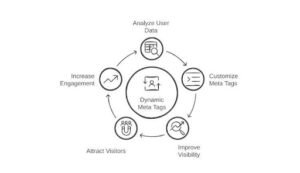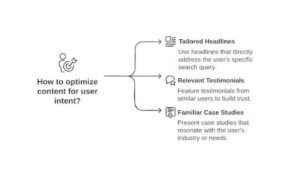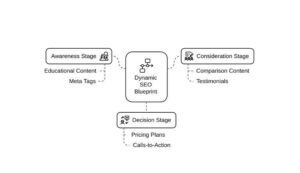Whenever an individual performs a search query, they expect more than just the search results; they expect relevance. A relevance that feels very personal, fast, and intuitive. This expectation is not formed only by search engines. It is seen in everyday usage of platforms such as Netflix and Amazon, where the content seems to be adapted as soon as you log in. Users can’t stand generic web behavior. If the content doesn’t feel right to them, they walk out. In fact, it turns out that nearly 74 percent of users say that they are frustrated when a site shows them content that doesn’t match their interests.
To meet the above expectations, a business requires more than just traditional SEO; it requires Dynamic SEO. Instead of static content and fixed keywords, dynamic SEO brings live updates to your site. It can change page titles, descriptions, and even on-page content in relation to who the visitor is and their interests. This makes SEO a living component of the user experience rather than just a visibility tool.
What makes this possible today is the emergence of advanced technology. AI, machine learning, and real-time data platforms have made personalizing experiences easier than ever. Companies that adopted this approach are beginning to see real results. Personalized web content contributes to an average increase in sales of 19 percent, which is proof that relevance is key.
This blog will provide a crystal-clear strategic picture of how to implement dynamic SEO that enhances engagement and conversion. We’ll explore how to mold the journey from search result to the final click using data, creating seemingly seamless yet personal experiences every step of the way.
-
Dynamic Meta Tags:
Meta tags are one of the most immediate approaches to introducing dynamic SEO to a website. These short descriptive words are perhaps the first communication seen when a site appears in search results telling you what it is. They form that all important first impression. However, for the most time, static meta tags continue to be used by businesses, which do not change from one visitor to another. Such an all purpose description does not address the different types of reasons that people might be searching in the first place.
For instance, consider the keyword “best running shoes”. One could be preparing for a marathon, the other may require arch support and yet another may simply be searching for the best price deal in his or her town. Static meta tags treat all these users in the same manner, and this results in low clicks and little or no qualified traffic.

In dynamic SEO, meta tags can be changed instantaneously. These changes can depend on the geographic location of visitors, the particular keywords they used, or even their position in the buying cycle. For example, if someone is searching for performance gear in Chicago, their title tag should reflect that specific search. But if they’re merely starting their research, the description can highlight expert advice or guides. The more customized the snippet, the more it stands out in search results. Backed by a high level of personalization, dynamic meta-tags not only enhance visibility and search engine rankings but also attract visitors likely to enrich the site, explore, and convert. For example, a general statement like “Shop for the Best Running Shoes” would turn into a dynamic snippet reading, “Find Marathon Running Shoes for Flat Feet in Chicago. Expert reviews and tips for your best race yet.” This addresses the user’s intent directly and builds trust with the user right from the first click.
-
Dynamic Content Optimization:
Dynamic meta tags are effective at attracting clicks, but dynamic content is essential for keeping visitors engaged once they arrive on your site.
Dynamic content is what animates the on-site experience. It means that the words, images, calls-to-action, and offers on a page shift depending on who the visitor is, where he or she came from, and what the user is doing. Be it a returning customer or a new visitor from a paid ad or perhaps a person searching with a particular intent: the page is adapting in real time to be where these people are.

This kind of experience goes even beyond the keyword matching. It gets into the deeper intent behind any visit. For example, if the user is searching for “CRM for small marketing agencies,” the site should not merely present a common pitch for CRMs. The headline could call marketing agencies by name, testimonials could speak to results from similar companies, and case studies could tell stories that feel relevant and familiar. These kinds of details establish trust quickly.
The same holds true for B2C. A travel site can recognize a search for “flights to Paris” and instantly feed hotel deals, travel tips, and city guides to the user. No clicks, no digging. Just right there fit for the task and without a hitch.
Dynamic content works because it eliminates friction. It instantly shows the visitors what they are interested in, and naturally, that gets them to engage more with the website, has less bounce or exit rates. There are statistical reports saying that companies creating personalized content with the sophisticated use of AI or machine learning have a 10 percent increase in customer satisfaction. This will make people feel nearer to the place, tend to stay longer, go looking for the next bits, and are likely to increase interest in what is next.
- Blueprint for Dynamic SEO
After capturing the attention of the users and delivering engaging and relevant content based on their purpose for visiting, the next step is to ensure the right message is delivered based on the stage of the funnel the user is on. This is why it is crucial to establish a clear and, if needed, strategic architectural vision.
A deep understanding of the customer’s journey is what is required to create a really effective dynamic SEO experience. In other words, think of it as a map that illustrates the journey of a consumer moving from discovery to loyalty. Each stage in such a journey presents a different set of questions, goals, and points of decision. And as those needs change, so should the SEO elements—both within search results and on site.

- Awareness Stage:
During the early awareness stage, it is usually about searching for information, answers, insights, or ideas. This is the time when educational blog posts, a guide, and explainer videos should be shown. The meta tags should reflect that tone in the promises of value; for example, an example promise of value is “Learn how to improve email open rates.”
-
Consideration Stage:
As users move into the consideration stage, they begin comparing options, with searches such as “Mailchimp vs. Constant Contact” or reviews. This is where dynamic content can yield side-by-side comparisons for features, testimonials, or case studies relevant to that specific industry or business size. Even meta tags can switch to include words such as “comparison” or “review,” aiding them in making a decision with confidence.
-
Decision Stage:
By this time in the journey, the user is poised to take action. The search behavior thus becomes transaction-oriented. Phrases such as “pricing,” “sign up,” or “demo” seem to take over. Meanwhile, it is crucial that dynamic elements of the page flash the given offer. Pricing plans, discounts, or solid calls-to-action such as “Start your free trial today” should be in the spotlight on the page.
An appropriate journey mapping does not only improve your search engine optimization, but forms the backbone of your personalization strategy as well. Here is where keyword analysis comes in quite handy in rankings and by identifying what each keyword reveals about the user’s mindset. The insight can fuel dynamic rules that ensure that every contact feels timely and useful. When you align your SEO with that of real users’ behavior, you’ll not be optimizing for algorithms. Instead, you’ll be configuring an experience adaptable to the person behind the search. And that’s the kind of relevance that keeps people moving forward.
- Data & Technology Powering Dynamic SEO
With the importance attached to synchronizing dynamic SEO with the customer journey, the next critical aspect is understanding the technology and data infrastructure that allows for personalization at scale. Once you know what the user needs at each stage, you need the right tools to collect insights and deliver tailored experiences seamlessly.
Today, the backbone of dynamic SEO is made by advanced technologies, such as machine learning (ML) and artificial intelligence (AI). These technologies collect huge data which have found its ways through user behavior, search trends, and contextual information, to identify patterns and perform predictions of user intent. Their signals will automatically trigger the corresponding dynamic elements precisely at the most opportune time, bringing to view only the most relevant content for users. Such a scale of automation is far what differentiates dynamic SEO from other types of SEOs regarding scalability and efficiency.
Web Personalization platforms are the technologies that enable the management and delivery of this kind of personalization, many of which are AI-facilitated. They can check and compare different forms of meta tags, on-site content, or even whole user experiences through A/B/n testing. This helps to determine how a company may reach out to various groups of users and positively guarantee that every visitor will be offered relevant content. Above all, these platforms unify data from various sources, including website activities, CRM systems, and even offline data. Create a single definite picture of each customer and enable the company to provide individualized experiences for everyone at all points of contact. This ensures that every interaction is appropriate and coherent, whether the user is using the sites, subscribed to a mailing list, or simply seeing an advertisement.
The impact of the use of AI and ML in personalization is evident, with research indicating that 75% of the companies that employ both said technologies realized a significant increase in customer satisfaction levels of at least 10%. Furthermore, through the aid of advanced platforms, the complexity involved in integrating different data sources was drastically minimized, thereby making dynamic SEO strategies more achievable than ever.
For example, an e-commerce site could use a web personalization platform to predict the category of products a user is likely interested in based on browsing behavior, dynamically changing the display of homepage banners and navigation to fit that prediction. In another instance, using an A/B testing platform for content optimization, a publisher dynamically inserts varying headlines into title tags and H1 tags based on traffic source or user segment to maximize click-through rates and engagement.
-
Measuring What Matters
There is no doubt that the concept of dynamic SEO has to be measured fully now. Identifying the right metrics is key in proving that dynamic SEO work does indeed deliver results in terms of business.
Although organic traffic and rankings still feature in traditional metrics for measuring SEO performance, dynamic SEO takes into account a number of other parameters as it relates to personalization and user behavior. Examples of such new KPIs that deserve tracking include click-through rates for dynamic meta tags, integration of user engagement metrics (time on page, bounce rates), and conversions as indicators of effectiveness. For businesses, particularly in B2B, lead quality and customer lifetime value (CLV) indicate the significance of personalized experiences for long-term growth and customer loyalty. All these metrics combine to tell the story of how dynamic SEO is really improving your website’s performance, driving engagement, and ultimately increasing conversions.
Conclusion:
Dynamic SEO is no longer an optional module but an essential tool that any business aspiring towards success in the modern world must take on board. By improving user experience, enhancing CTR, and having rewarding interactions, dynamic SEO helps business owners make real and effective connections with their customers. Once a choice for possible inclusion in marketing strategies, it is now something that must be included to be effective. As customer expectations continue to evolve, dynamic SEO should now become a major strategic tool for overcoming competition and ensuring long-term success in an increasingly competitive market.
Author Bio:[Image Link]

Vidhatanand is the Founder and CEO of Fragmatic, a web personalization platform for B2B businesses. He specializes in advancing AI-driven personalization and is passionate about creating technologies that help businesses deliver meaningful digital experiences.
